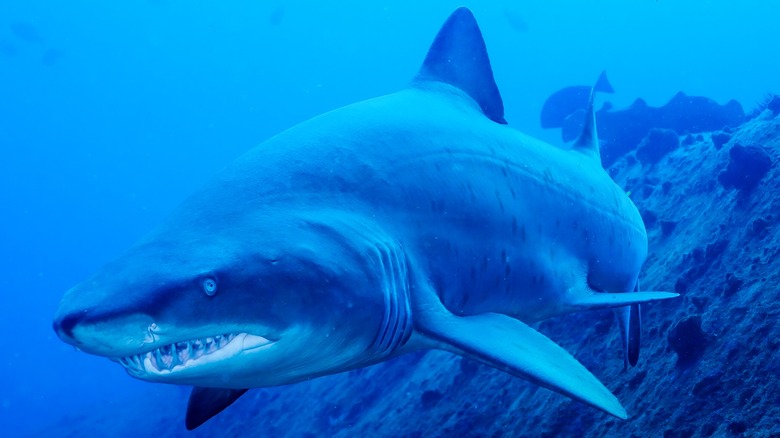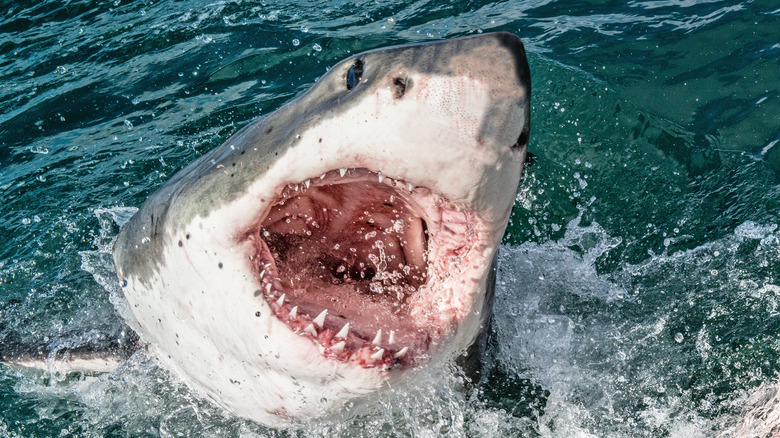The Celebratory Gesture That Is Said To Kill More People Annually Than Sharks
We humans, generally speaking, are rather hardy creatures. We may not have the great bulk of the elephant, the tough skin of the crocodile, or the formidable exoskeleton of the diabolical ironclad beetle, but we're rather resilient as a species. Incidentally, the latter, according to UCI professor David Kisailus (via Phys.org), is "a terrestrial beetle ... a little tank ... It can't fly away, so it just stays put and lets its specially designed armor take the abuse until the predator gives up." That's very tough. We're just relatively tough. This means, unfortunately, that we can die in a wide variety of quite implausible, statistically very unlikely ways.
Have you ever celebrated a birthday, a holiday, a wedding, a promotion, or other such happy event with a merry uncorking of a champagne bottle? It's a celebratory gesture as natural as breathing to many. The thing is, though, there's a reason we're reminded to take care when doing so. It may not "take someone's eye out," literally, but the chances of being killed by an errant cork are higher than you might think.
Sharks: not the monsters of the sea they're sometimes painted as
Fear of sharks — what with their size, their teeth, and the "Jaws" movie franchise — is logical. These animals, however, are to be respected and understood, not feared. Sharks are not all huge, fearsome killers. Guinness World Records states that the smallest shark species on the planet is believed to be the dwarf lantern shark: mature males are reportedly just 6.3 to 6.8 inches (16 to 17.5 centimeters) long.
Even those infamous powerhouses — the great white sharks — are the furthest thing from ravenous human hunters. The October 2021 study "A shark's eye view: testing the 'mistaken identity theory' behind shark bites on humans" in the Journal of the Royal Society Interface supports the notion that white sharks generally bite humans only because they mistake them for their actual prey. The scientists studied the way humans move in the water, the shape they take, and so on and compared the data with that of seals.
"From the perspective of a white shark," the experts concluded, "neither visual motion nor shape cues allow an unequivocal visual distinction between pinnipeds and humans, supporting the mistaken identity theory behind some bites." Younger white sharks seem to be more likely to bite humans, the study goes on, and there's still uncertainty as to why attacks with no provocation occur. They remain rare, though. In fact, a person seems to be statistically more likely to be killed by a champagne cork than a shark.
Are champagne corks the real enemy?
Champagne corks are, surprisingly, very hazardous. As the Vanderbilt Eye Institute's Dr. Mark Melson told Live Science in 2009, "Eye injuries from flying champagne corks, especially around the holidays, are fairly common ... damage can range from corneal abrasions to retinal detachment." This, according to the outlet, is due to the dizzying speed the cork is traveling when carelessly allowed to careen out of the bottle: it can be as quick as 60 miles per hour.
Matt Roper's "101 Crazy Ways to Die" states (per the Daily Mail), "Of the nearly two dozen champagne-accident fatalities a year, more than a third occur at weddings." According to Roper, this makes said corks deadlier on an annual basis than bites from poisonous spiders. Interestingly, corks are apparently rarely ingested. In December 2007, The BMJ published the piece "Champagne: the safer choice for celebrations." It concerned the case study of a 24-year-old athlete who had the cap of a beer bottle removed by an endoscopy. "A comprehensive Medline search failed to elicit an example of oesophageal obstruction secondary to the ingestion of a champagne (or wine) cork. Since the 18th century, champagne has been the beverage of choice for celebrations and on current evidence should remain so," the piece concluded. It's clear, nevertheless, that flying corks should be treated with great care.
Sharks vs. corks
Precise numbers of cork deaths each year (whether domestic or worldwide), as Toronadosd reports, are all but untrackable. The outlet offers 24 each year as a figure, close to the number suggested in Matt Roper's book. We do know, however, that the American Academy of Ophthalmology takes the threat very seriously indeed. Dr. Monica L. Monica of the academy said, "When a champagne cork flies, you really have no time to react and protect your delicate eyes. Uncontrolled champagne corks can lead to painful eye injuries and devastating vision loss." the academy also offers safety guidelines for opening bottles, which include, "Twist the bottle while holding the cork at a 45-degree angle to break the seal" and "Counter the force of the cork using downward pressure as the cork breaks free from the bottle."
Sharks, meanwhile, are an even more unlikely threat, statistically speaking. "Critical Skills for Environmental Professionals: Putting Knowledge into Practice" by Jennifer Pontius and Alan McIntosh (via Google Books) states that a given person's chance of being killed by a shark is 1 in 3,700,000. The chance of dying from influenza, by contrast, is 1 in 63.
The Florida Museum's International Shark Attack File states that 2021 saw 11 people killed by sharks worldwide. Two of them were deemed provoked, and the yearly average of unprovoked human killings by sharks is just five. This could indeed mean that champagne corks kill more people than sharks.



